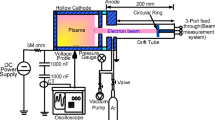Abstract
A high-energy electron beam was produced by a multi-gap pseudospark device under high breakdown voltages. In this work, a simulation model was developed to ascertain the mechanism of the discharge process in the multi-gap pseudospark, which was verified by the triggered multi-gap pseudospark discharge experiment. The characteristics of the plasma were investigated for different anode voltages and pressures. Results suggest the formation of a virtual anode in the cathode aperture during the discharge process, followed by the release of an electron from the plasma in the triggered hollow cavity. The propagation velocity of the ionization wave stimulated by the electron beam is increased with pressure and applied voltage on the anode. The highest density of the particles was found in the region of the cathode aperture. The densities of the particles in the aperture of the intermediate electrodes are higher than at the right adjacent side gaps when the entire gap space is filled with the plasma. The peak of the electron distribution function is found to be situated at higher energies at the beginning of discharge, then the electron distribution function gets shifted to lower energies on the completion of discharge.














Similar content being viewed by others
References
Christiansen J, Schultheiss C (1979) Z Phys A 290:35–41
Korolev YD, Landl NV, Geyman VG, Frants OB, Bolotov AV (2017) AIP Adv 7:075116
Korolev YD, Landl NV, Geyman VG, Frants OB, Shemyakin IA, Nekhoroshev VO (2016) Plasma Phys Rep 42:799–807
He W, Zhang L, Bowes D, Yin H, Ronald K, Phelps ADR, Cross AW (2015) Appl Phys Lett 107:133501
Jiang C, Kuthi A, Gundersen MA, Hartmann W (2005) Appl Phys Lett 87:131501
Frank K, Christiansen J (1989) IEEE Trans Plasma Sci 17(7):48–53
Yin H, Phelps ADR, He W, Robb GRM, Ronald K, Aitken P, McNeil BWJ, Cross AW, Whyte CG (1998) Nucl Instrum Methods Phys Res Sect A 407:175–180
Zhao J, Yin H, Zhang L, Shu G, He W, Zhang J, Zhang Q, Phelps ADR, Cross AW (2016) Phys Plasma 23:073116
Korolev YD, Koval NN (2018) J Phys D Appl Phys 51:323001
Frank K, Petzenhauser I, Blell U (2007) IEEE Trans Dielectr Electr Insul 14:968–975
Stetter M, Felsner P, Christiansen J, Frank K, Gortler A, Hintz G, Mehr T, Stark R, Tkotz R (1995) IEEE Trans Plasma Sci 23:283–293
Benker W, Christiansen J, Frank K, Gundel H, Hartmann W (1989) IEEE Trans Plasma Sci 17:754–757
Varun D, Pal UN (2018) IEEE Trans Electron Devices 65:1542–1549
Kumar N, Lamba RP, Hossain AM, Pal UN, Phelps ADR, Prakash R (2017) Appl Phys Lett 111:213502
Kumar N, Pal DK, Lamba DP, Pal UN, Prakash R (2017) IEEE Trans Electron Devices 64:2688–2693
Kumar N, Jadon AS, Shukla P, Pal UN, Prakash R (2017) IEEE Trans Plasma Sci 45:405–411
Kumar N, Pal DK, Jadon AS, Pal UN, Rahaman H, Prakash R (2016) Rev Sci Instrum 87:033503
Zhao J, Yin H, Zhang L, Shu G, He W, Phelps ADR, Cross AW, Pang L, Zhang Q (2017) Phys Plasma 24:033118
Zhao J, Yin H, Zhang L, Shu G, He W, Zhang Q (2017) Phys Plasma 24:023105
Zhao J, Yin H, Zhang L, He W, Phelps ADR, Cross AW (2017) Phys Plasma 24:060703
Huang Y, Wang M, Zhang L, Lu B, Feng C, Zhou H (1996) Acta Opt Sin 10:1493–1496 (in Chinese)
Lamba RP, Pal UN, Meena BL, Prakash R (2018) Plasma Sources Sci Technol 27:035003
Jain KK, Boggasch E, Reiser M, Rhee MJ (1990) Phys Fluids B 2:2487–2491
Jiang XL, Han LJ (1992) Rev Sci Instrum 63:2420–2421
Frank K et al (1997) IEEE Trans Plasma Sci 25:740–747
Verboncoeur JP, Langdon AB, Gladd NT (1995) Comput Phys Commun 87:199–211
Hagelaar GJM, Pitchford LC (2005) Plasma Sources Sci Technol 14:722–733
Vahedi V, Surendra M (1995) Comput Phys Commun 87:179
Saravanan A, Prince A, Suraj K (2017) Phys. Plasma 24:112106
Shuiliang M, John H, Nandika T (2011) Phys Plasma 18:083301
Weihao T et al (2018) Plasma Sources Sci Technol 27:015005
Lagarkov AN, Rutkevich IM (1994) Ionization waves in electric breakdown of gases. Springer, New York
Acknowledgements
The authors would like to thank Pro. Klaus Frank for a discussion regarding the multi-gap pseudospark discharge process. This work was supported in part by the National Natural Science Foundation of China under Grant No. 11705134, the Project funded by Shaanxi Province Postdoctoral Science Foundation (Grant No. 2017BSHEDZZ120) and the Natural Science Basic Research Plan in Shaanxi Province of China (Program No. 2018JQ1044).
Author information
Authors and Affiliations
Corresponding author
Additional information
Publisher's Note
Springer Nature remains neutral with regard to jurisdictional claims in published maps and institutional affiliations.
Rights and permissions
About this article
Cite this article
Zhang, J., Zheng, Y. Simulation for the Characteristics of Plasma of the Multi-gap Pseudospark Discharge. Plasma Chem Plasma Process 39, 969–984 (2019). https://doi.org/10.1007/s11090-019-09983-8
Received:
Accepted:
Published:
Issue Date:
DOI: https://doi.org/10.1007/s11090-019-09983-8




